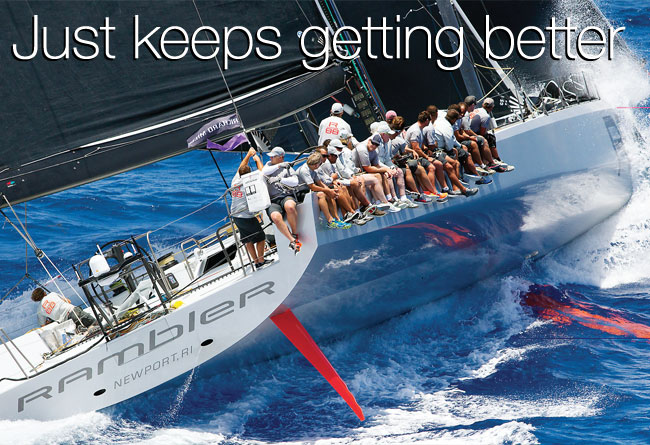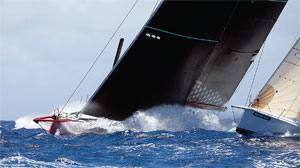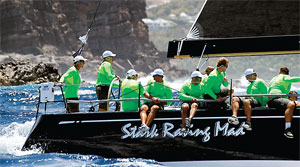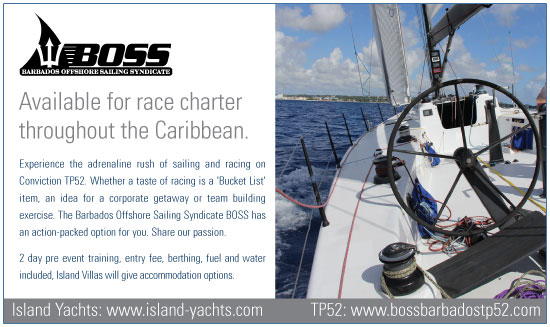

Once the most convivial of holiday racing destinations, the Caribbean circuit is now a little more serious than that. But it’s still just about bearable… as former Alinghi America’s Cup helmsman and local Caribbean resident Peter Holmberg confirms
From what was once a very enjoyable and desirable, if casual, diversion from mainstream racing, or simply a warmer alternative to that annual skiing vacation, the Caribbean regatta circuit has evolved and matured into a serious gathering of top race yachts and their crews.
Flowing seamlessly on from the Florida regattas at the start of each year, an ever increasing number of the best-known raceboats – large and small – now make the short journey south… postponing for as long as possible their return to less balmy northern racing climes.
Long gone are the days of Caribbean events predominantly being run for the region’s charter fleets, plus enthusiastic locals with lovingly preserved and maintained ‘older’ racers. Today the harbours of the Caribbean are filled to overflowing with some of the best racing machinery and best racing sailors on the planet. Sailors are still extremely fortunate to find themselves racing in this part of the world every year… but each year it also gets a little harder to take home the silver.
The regattas
The Caribbean season kicks off mid-January in Barbados, and then wraps up with Antigua Sailing Week in May. The CSA website has a nice five-year calendar of all the major events at caribbean-sailing.com.
Individually each event is unique, some are thriving, some are holding their own, and some are trying to retool to meet the changing market and trends. In general, the newest fixtures are the most popular. They started with a blank sheet, modelled their event to current trends, have some good people behind them who saw a need and filled it, and enjoy a bit of the new girl in town syndrome.
So the two newest events, the Caribbean 600 and Voiles de St Barths, continue to lead the popularity contest, and they are doing a great job. While the longstanding events benefit from name recognition and history, they have the challenge of exciting and attracting the new boats. What has worked for 40 years may not necessarily work for today’s boats and sailors. These events are tasked with trying to refresh against the usual pull of tradition, and within the physical constraints of their location.
So starting at the beginning of the season, here’s an inside look at the major events. The Mt Gay Barbados Series in January is definitely on the upswing and starting to attract more boats.
Good efforts are being made by the organisers to promote the event and they have expanded from just an around-the-island race to a full week of racing. This year two highpowered MOD 70s came to play, Concise and Phaedo, and shattered the Around the Island record.
Immediately following this is Grenada Sailing Week. If you are looking for a local regatta with real island charm, this is the one. This event attracts all the southern Caribbean boats and offers some nice ‘ol style’ regatta ambiance.
Mid-February is the RORC Caribbean 600, which has already been well covered in Seahorse. Basically it’s a brilliant concept for a race, and continues to grow in popularity: 600 miles, rounding 11 islands in the Caribbean, held in the middle of the winter.
This year’s race was a good one, with 12-25kt winds, a full moon and some very close racing.
One week later is the St Maarten Heineken regatta. This event could best be described as a sailing music festival, with the parties sharing equal billing with the racing. This is the biggest regatta in the region, with over 200 entries representing the full spectrum from charter boats to cruisers, catamarans, beach cats and raceboats. The challenges facing this event are the serious traffic on the roads and the fact that most of the boats have to wait on the limited bridge openings to get to and from the racecourse each day; but the island is keen to promote its big event and more frequent bridge openings are now being discussed.
Next up in March are the two Superyacht events on back-to-back weekends: the Loro Piana in Virgin Gorda BVI, and the St Barths Bucket. The Loro Piana is relatively new and yacht owners and crew seem to love it. The YCCS facility and the setting in North Sound are both spectacular, and the racecourses around islands in mostly sheltered waters suit this fleet well.

Above: the big boys who are now regular visitors to the Caribbean circuit each winter don’t come much bigger than Comanche… well, at least outside the superyacht class where giants like the 236-foot all-carbon Hetairos regularly turn up to join the fun. The Swan 601 Stark Raving Mad (below) looks rather modest by comparison

The challenge for the event is the limited housing options for the massive crew numbers, so good advice is to book early at the nearby resorts, or get creative and use charter boats as floating villas. The Bucket is the unofficial Superyacht worlds, and organisers continue to set the benchmark for this class of yachts. They do a great job of identifying and then acting on the issues of this fast-growing class, be it safety, rules, smart courses, class breaks or tactician briefings. There are some unique challenges to racing these big boats and all of us need to help by minimising the risks to keep this game alive. The new ORCsy rating rule was used at both events and seemed to do a good job in general, but some work is still obviously needed to catch the full range of these diverse yachts.
Next up is the St Thomas International Regatta, or STIR, which for 40 years was the Rolex Regatta. This event has some of the best geo - graphy for island courses and scenic racing, with many islands and rocks to round, lots of course options, and tricky currents and winds to play.
This year saw a fleet of VX Ones shipped in for the event, a new Gunboat class, the usual big IC24 class (a redecked J24), plus a good mix of racing and cruising classes.
Unique to this event is the central setting of the yacht club in Cowpet Bay as the regatta base, and four surrounding hotels plus condos that make housing easy. Its primary challenge is the lack of dock facilities for the bigger boats. Where anchoring in the beautiful bay used to be the feature of racing here, it’s now one of the challenges. The organisers are considering their options, one of which is to create a satellite base at a big marina to cater for the boats that need more dock space.
Four days later and only eight miles away is the BVI Spring Regatta in Tortola, making these two sister events a nice combination for sailors wishing to get in two great events in a 10-day period. The BVISR does a really nice job of tweaking their racing format and courses each year, while keeping their fun regatta village setting at Nanny Cay in place. By next year they will have a deep-water marina completed which should help attract more big boats. This year saw a nice turnout for the event, some beautiful weather and good racing across a full range of classes.
Ten days later in mid-April is the Voiles de St Barths. It helps when your regatta is based on an island that is considered the darling of the Caribbean. It also helps when you have a smart team of people working all year at making the regatta better. Combined, this translates into one of the nicest events in the world. Even with the challenge of limited docking and draft restrictions forcing the big boys to live at anchor, the owners and crew all seem to love it. This year saw some unusually light air, but great racing nonetheless. The 2016 fleet included the big boats Comanche, the new Wally 100 Galateia, the R/P 82 Highland Fling and a couple of Maxi 72s. Other hot boats included the Volvo 65 Brunel, four TP52s, the big Kers Tonnerre and Varuna, plus everything else down to Melges 24s and multihulls.
The final event of the season is Antigua Sailing Week at the end of April. This regatta pretty much started it all as the first big international event in the Caribbean. And it offers a great example of how events have retooled to meet changing markets and trends. Whereas the event used to move around the island to a different start/finish point each day and teams would sleep aboard their boats, now they have changed to a centrally located regatta base in Falmouth Harbor that simplifies logistics. Antigua is still old world nice, and is one of the most sailorfriendly islands in the Caribbean. This coupled with great organisation is bringing a new and improved Antigua Week back to the forefront.
Peter Holmberg, St Thomas
Click here for more information on The Caribbean Sailing Association »


We invite you to read on and find out for yourself why Seahorse is the most highly-rated source in the world for anyone who is serious about their racing.
To read on simply SIGN up NOW
Take advantage of our very best subscription offer or order a single copy of this issue of Seahorse.
Online at:
www.seahorse.co.uk/shop and use the code TECH20
Or for iPad simply download the Seahorse App at the iTunes store


